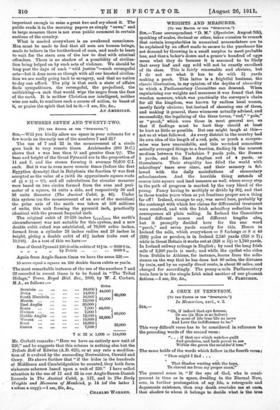NUMBERS SEVEN AND TWENTY-TWO.
[To TER EDITOR 05 THE " SPRCTATOR." J SIR,—Will you kindly allow me space in your columns for a few words on the early use of the numbers 7 and 22 ?
The use of 7 and 22 in the measurement of a circle goes back to very remote times. Archimedes (200 B.C.) shows that v was less than .P,4- and greater than V-it. The base and height of the Great Pyramid are in the proportion of 11 and 7, and the stones forming it average 70,030 C.I. each. But it was in even more remote times (before the first Egyptian dynasty) that in Babylonia the fraction - was first accepted as the value of w (with its approximate square roots of lax = -yl), and all calculations for circular measure were based on two circles formed from the area and peri- meter of a square, 44 units a side, and respectively 50 and 56 units diameter (The Ancient Cubit, p. 46). Under this system ton the measurement of an arc of the meridian) the polar axis of the earth was taken at 500 millions of units, this unit forming the pyramid inch, practically identical with the present Imperial inch.
The original cubit of 30.258 inches (,„„01„„„,, the earth's circumference) was not suitable for this system, and a new double cubit cubed was established, of 70,000 cubic inches, formed from a cylinder 28 inches radius and 28 inches in height, giving a double cubit of 41-,3- inches (cube root of 70,048). As a test of this we have:— Base of Great Pyramid 220 double cubits of 41: in. = 9068.8 in.
„ by Petrie ... 9068.8 „ Again from Anglo-Saxon times we have the same 220:— 10 acres equal a square on 220 double Saxon cubits or yards.
The most remarkable instance of the use of the numbers 7 and 22 recorded in recent times is to be found in "The Tribal Hidage,” Trans. Royal Hist. Soc., 1900, by W. J. Corbett, M.A., as follows :—
Bernicia Deira South Humbria Mercia East Anglia Essex ...
II wince ...
Middle Anglia Wessex ... Kent Sussex ... • ..
• . ••• ••• ••• *** "• ••• .• • •••
Hide&
30,0001 44,000 14,000 J
10,0002 22,000
••• 12,000 5
••• 30,000 ••• 7,000 44,000 ••• 7,000
• •• 12,000 10,000 22,000 15,000 1 7,000 f
7 X 22 X 1,000 =
66 000 66000 22,000 154,000
Mr. Corbett remarks : "Here we have an entirely new unit of 220," and he suggests that this scheme is nothing else but the Tribute Roll of Edwine (A.D. 625), or at any rate a modifica- tion of it evolved by the succeeding Bretwalders, Oswald and Oswy. He shows further that " if the hides in the hundreds of Middlesex and Cambridgeshire be counted, they both form elaborate schemes based upon a unit of 220." I have called attention to the use of 11 and 22 in our Anglo-Saxon-Danish Records in The Ancient Cubit, p. 117, and in The Early 1 Veights and Measures of Mankind, p. 14 (of the latter I s =lose a copy).—I am, Sir, &a.,
CHARLES WARREN.


































 Previous page
Previous page